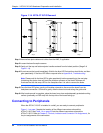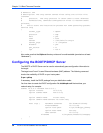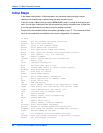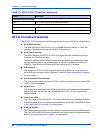
3
ATCA-C110/1G Installation and Use Manual
29
REVIEW COPY
3 U-Boot Firmware Overview
U-Boot is a software package based on an open-source boot loader for embedded systems
utilizing PowerPC, MIPS, or ARM Processors. U-Boot can be installed in a boot ROM and used
as a boot loader to download and activate application code.
For more detail on using U-Boot and a listing of all commands, refer to the ATCA-C110/1G
U-Boot Installation and Use Manual, listed in Appendix D, Related Documentation.
System Setup
Some tools are needed to install and configure U-Boot and Linux on the target system. Also,
especially during development, you require interaction with the target system. This section
describes how to configure your host system for this purpose.
Serial Console Access
To use U-Boot and Linux as a development system and fully utilize all their capabilities, you
need access to a serial console port on your target system. Later, U-Boot and Linux can be
configured to allow automatic execution without any user interaction.
To access the serial console port on your target system, connect one end of the serial cable to
serial port (COM5 on the ARTM-C110) and the other end of the serial cable to the host COM
port.
Configuring the TFTP Server
The quickest manner for U-Boot to load a Linux kernel or an application image is through file
transfer over Ethernet. For this purpose, U-Boot implements the TFTP protocol (see DENX
U-Boot and Linux Guide which may be obtained online from the
http://www.denx.de/twiki/bin/view/DULG/Manual site).
To enable TFTP support on your host system you must make sure that the TFTP daemon
program /usr/sbin/in.tftpd is installed. On RedHat systems you can verify this by running:
$ rpm -q tftp-server
If necessary, install the TFTP daemon program from your distribution media.
Most Linux distributions disable the TFTP service by default. To enable the TFTP service, for
example on RedHat systems, edit the file /etc/xinetd.d/tftp and remove the line
disable = yes
or, comment the line by prefixing a hash character. For example:


















